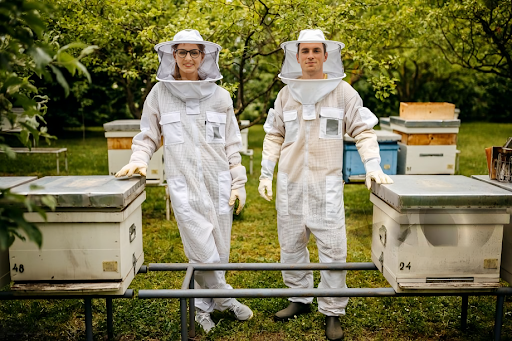Ventilated bee suits are a crucial investment for beekeepers, offering protection and comfort during hive inspections. However, to ensure they remain effective over time, it’s important to clean and maintain them properly. A well-maintained bee suit not only lasts longer but also provides consistent protection from stings. In this guide, we’ll walk you through the steps to clean, maintain, and store your ventilated bee suit, helping you get the most out of your beekeeping gear.
Why Proper Maintenance Matters
Your ventilated bee suit faces daily exposure to sweat, dirt, bee residue, and even propolis. These elements can clog up the mesh fabric, reducing the breathability of the suit and making it uncomfortable to wear. Proper cleaning keeps the ventilation working effectively and helps avoid any buildup that might compromise the protective layers of the suit. Plus, a clean bee suit makes your beekeeping experience more pleasant!
Step-by-Step Guide to Cleaning Your Ventilated Bee Suit
- Prepare for Washing
Before you begin cleaning, inspect your suit for any visible stains, sticky propolis spots, or small tears that might need attention. Remove any loose debris like twigs or leaves from pockets and zippers. If possible, detach the veil or hood from the suit, as this can help ensure a more thorough clean without damaging the mesh material. - Spot Cleaning
If you notice any stubborn stains or propolis buildup, spot-clean these areas first. Use a soft brush or an old toothbrush with a mild detergent to gently scrub the affected spots. Avoid harsh chemicals, as they can damage the fabric and reduce the longevity of your suit. - Hand Wash or Machine Wash?
Ventilated bee suits can usually be washed by hand or in a washing machine, but it’s essential to check the manufacturer’s care instructions. If using a washing machine, select a gentle cycle with cold or lukewarm water. Add a mild detergent, preferably one without strong fragrances, to avoid attracting bees during your next hive inspection. - Hand Washing Instructions
If you choose to hand wash, fill a large basin or bathtub with cold water and a small amount of mild detergent. Submerge the suit and gently agitate the water, paying extra attention to heavily soiled areas. Allow the suit to soak for about 15-20 minutes, then rinse thoroughly with cold water until all soap residues are removed. - Rinse Thoroughly
Whether washing by hand or machine, ensure the suit is rinsed thoroughly. Leftover soap can attract bees or cause irritation when you wear the suit next. Run the suit through an extra rinse cycle if you are using a washing machine, or rinse by hand under running water until the water runs clear. - Drying the Suit
After washing, avoid wringing or twisting the suit, as this can damage the delicate mesh. Instead, lay the suit flat on a clean, dry towel and roll it gently to remove excess water. Then, hang the suit in a shaded, well-ventilated area to air dry. Avoid direct sunlight, as prolonged UV exposure can weaken the fabric over time.
Maintaining Your Ventilated Bee Suit
- Inspect for Damage
Regularly inspect your suit for any rips, tears, or worn-out sections. Pay close attention to the seams, zippers, and the mesh areas of the veil. Small holes can allow bees to enter, so it’s essential to repair any damage as soon as you notice it. - Patch Small Tears
Small rips or holes in the fabric can be patched with sewing kits or fabric repair patches designed for breathable materials. Follow the instructions on the patch, and ensure the repaired area remains secure and does not hinder the ventilation of the suit. - Check and Lubricate Zippers
Over time, zippers can become stiff or difficult to use. Apply a small amount of zipper lubricant or even a little candle wax to keep them running smoothly. Make sure to clean out any debris caught in the zippers to prevent jamming. - Store Properly
When not in use, store your ventilated bee suit in a cool, dry place. Avoid leaving it in damp areas where mold or mildew can develop. Use a garment bag or a large cotton pillowcase to store the suit, allowing airflow while keeping it safe from dust and pests.
Tips for Long-lasting Use
- Avoid Harsh Chemicals: Using bleach or strong detergents can weaken the mesh and fabric of your suit, making it less effective over time. Always opt for mild, eco-friendly detergents.
- Do Not Iron: Ironing can damage the delicate mesh and synthetic materials in your ventilated bee suit. If wrinkles are a concern, use a low-heat steamer at a safe distance.
- Wash Regularly: Make sure to wash your bee suit after every few uses, especially if you’ve been sweating heavily or working with aggressive colonies. This keeps the suit clean and ensures that the ventilation remains effective.
- Rotate Suits: If you keep bees regularly, consider having more than one ventilated bee suit. Rotating between suits allows each one to air out properly between uses, extending their overall lifespan.
Conclusion
By following these steps, you can keep your ventilated bee suit in top condition, ensuring it stays comfortable and protective for years. Proper cleaning, regular maintenance, and smart storage practices can go a long way in preserving the integrity of your beekeeping gear. Whether you’re a beginner or a seasoned beekeeper, investing a little time in maintaining your suit will pay off in the long run, keeping you safe and comfortable during every hive visit. Happy beekeeping!







